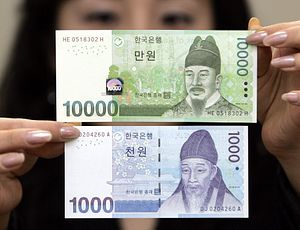The U.S. Treasury’s semiannual foreign currency report once again determined that South Korea does not meet its criteria of a currency manipulator. While South Korea remains on Treasury’s monitoring list, the report acknowledges the relevant indicators are heading in the right direction.
The impetus for the report comes from legislation in 1988 and 2015, requiring the treasury secretary to monitor major trading partners for policies that undervalue local currencies. This is of particular concern to Congress because an undervalued trading partner’s money encourages export-led growth in that country at the expense of U.S. competitors. The 2015 law outlines three criteria to be tracked for individual countries: (1) a significant bilateral trade surplus with the United States, (2) a material current account surplus, and (3) persistent intervention in the foreign exchange market to limit the value of the local currency. Treasury has the discretion to interpret each and has set the thresholds as (1) a $20 billion or more bilateral goods trade surplus, (2) a current account surplus larger than 3 percent of GDP, and (3) net foreign currency purchases of more than 2 percent of GDP in the previous year. If a country meets all three criteria it is deemed a currency manipulator; meeting two out of the three lands you on the monitoring list.
South Korea has again met the first two criteria but is in better standing than it has been in recent reports.
Although the $21 billion goods trade surplus observed in the last year through June 2018 exceeds Treasury’s threshold, it has steadily been in decline from the 2015 peak of $28 billion. More recent numbers show that it is still falling. The U.S. bilateral goods trade deficit with South Korea in July and August is down a combined $756 million from the same period last year. If this trend continues, by the time the next report is released in April 2019, South Korea will not meet the trade surplus criteria for the first time since it was incorporated in a report in 2016.
South Korea’s current account surplus of 4.6 percent of GDP meets Treasury’s threshold but has also been in general decline since 2015. Among the 13 trading partners analyzed in the report, South Korea is tied with China for the largest decrease in a current account balance as a percentage of GDP over the past three years. The surplus continued to decline through the first half of the year and remains down through August despite a major jump in May. However, unlike the bilateral trade surplus, the current account balance will likely still be higher than Treasury would like come April.
Currency intervention was once again not an issue as net purchases of foreign exchange were only 0.3 percent of GDP. Though the volume of currency intervention has not been a major concern in recent years, South Korea’s lack of transparency has. This most recent report made it clear Treasury welcomes Seoul’s decision to begin publicly reporting foreign exchange interventions in 2019.
The report similarly praised South Korean government efforts to support domestic demand through fiscal spending, specifically referencing the Moon administration’s proposed 2019 budget, which would be 9.7 more than this year’s budget.
Despite trending in the right direction, Seoul will likely continue to pay special attention to this report as there is always the possibility of the criteria being changed or expanded. Recent remarks from U.S. Treasury Secretary Steven Mnuchin suggests that he is considering making the criteria more stringent, a sharp contrast from his comments early on in the administration. As Stephanie Segal of the Center for Strategic and International Studies (CSIS) points out, the Trump administration has already inserted subjectivity into the report. By including new criteria that keeps a country on the monitoring list if it constitutes a “large and disproportionate share of the overall U.S. trade deficit even if that economy has not met two of the three criteria from the 2015 Act,” Treasury essentially altered the rules to keep China on the list.
While Treasury’s focus has been on China, some experts contend more attention should be paid to other trading partners, including South Korea. Brad Setser of the Council on Foreign Relations includes South Korea in his list of five countries whose currency practices merit more scrutiny. He cites foreign currency investments by the National Pension Service, which is run by the government and has large enough holdings to influence the value of the Korean won but is not tracked by Treasury, as an unaddressed area of concern. Additionally, in 2016 the Financial Times published an article suggesting South Korea manipulates its currency, but it was taken down after an official protest from Seoul.
However, there also seems to be a consensus among experts that going after anyone other than China right now would detract from the administration’s core goal of pressuring Beijing. Even so, because of the large bilateral trade ties South Korea has with China, if Beijing was named a currency manipulator, the stigma could spill over into the South Korean economy as was a major concern in the lead-up to a feared “April crisis” in early 2016.
Although South Korea has avoided the currency manipulator label, staying on the U.S. Treasury’s good side requires a sustained effort. Seoul has done a lot to quell Washington’s currency concerns, particularly by making its foreign exchange interventions public, but keeping up with the review process is never truly over.

































